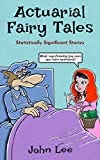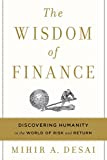Have an Actuarial New Year! A few Actuarial Gifts and Recommendations
On the 9th day of Christmas you get some really nerdy gifts
You may have seen this recent story in the WSJ:
Actuaries quantify risk. One of their riskiest endeavors is trying to become one.
Among people taking at least one exam from the Society of Actuaries—the field’s biggest U.S. credentialing body—15% eventually pass the multiple tests required to become an Associate, one of two designations allowing them to practice. Just 10% pass those and additional tests to become a Fellow, the group’s higher designation, which affords bigger responsibilities and salaries.
It’s such an arduous process that the number of test-takers has been declining in recent years, and the society is making changes to keep candidates from dropping out of the gantlet. It is also adding new “predictive analytics” tests to adjust to the massive amounts of data insurers now have.
Sigh.
Look, let’s be real: a lot of people start the exams who never get a job in the field, and so stop taking the exams. That said, I have worked with a lot of people in the insurance biz who stopped taking the exams, and many (or, rather, most) credentialed actuaries work in positions that don’t even require the credential. Indeed, the only position I’ve ever worked that was within sptting distance of requiring the credential was one in which I left after a year (and if I hadn’t have left, I would have been laid off with everybody else, as usually happens in an M&A.) It’s a difficult credentialing process, but you don’t accrue debt in pursuing this credential, which is its biggest plus.
My mother, having seen this:
Asked me if the questions really were like that, and the answer is yes. But those are just the early exams. The later exams have questions that… you know what? I’m not going to show you those. If you run into those, you definitely know what you’re getting into, and I have no intention of scaring the rest of you.
Something lighter from John Lee (and more below): titled “Actuaries and their children”
A more realistic picture: (from 2003, a picture of me and my oldest child, with my Loss Models textbook near her outstretched hand…and definitely not posed)
I sometimes grade the exams which is a lot less stressful than taking the exams, that’s for sure.
Actuarial New Years Wishes
If you don’t know what q_x is, here ya go:
Some actuarial folks I recommend
John Lee is an actuarial tutor in the UK, with a few books under his belt that may be of interest to actuarial types. His latest book is Actuarial Fairy Tales: Statistically Significant Stories
He also has a substack where he shares his humor: actuarialtutor.substack.com.
One of his I enjoyed:
John Bury, of course, I’ve been following for years at burypensions, especially for his take on New Jersey pensions and multiemployer pensions. He has been fabulous of late covering the disaster that is the Special Financial Assistance program that was in the Biden legislation that passed in the spring (the one I called the Moneypalooza Monstrosity, and yes that’s the one that passed).
SFA is not going so well. I hope to return to this myself this year, because this absolutely has to get fixed soon. Not due to any political calculation, but because some very big plans will wipe out the PBGC MEP plan within a decade.
By the way, Bury has announced that he is looking to sell/merge his own pension practice – check out his post for details.
Elizabeth Bauer, aka Jane the Actuary, continues to write at Forbes, has been busy recently with an economics graduate program, and she’s pretty active on twitter (like me) and is Catholic (also like me).
Mentioning twitter reminds me — I still have my Actuary/insurance/pension Twitter list. I started it waaaaaay back around the time when Twitter started lists, I think.
There are loads of actuaries I know, of course, in real life, and ones I just chat with from afar. The place I go to, other than Twitter and LinkedIn, is goActuary — you don’t have to be an actuary to join the community, but it doesn’t hurt!
(or maybe it does.)
A risk-adjusted view on life
This is not necessarily a gift, but a reminder that life is limited, just by being human. I did a write-up on my LiveJournal this morning (I know, dudes — I’ve been there almost 21 years, and I’m not about to leave yet).
I’m regifting somebody else’s observation:

The tweeter was quoting their father, who had been diagnosed with cancer in 2019.
One of the biggest problems during the pandemic has been a bunch of people making decisions for other people without regard to the consideration that people have different levels of risk and risk tolerance. The people who had composed and signed the Great Barrington Declaration had wanted a focus on the most vulnerable to pandemic mortality and morbidity, to protect them, while reducing strictures on those with less risk. That was keeping in mind that people spread the virus around in a pandemic, but that the ability to control that spread is limited for an airborne disease.
But even for the most vulnerable, there is a balance to be had — what are you preserving life for? If you lock a person in a box to “protect” them, but the life they’re living in that box is unbearable… what then?
This is not just a perspective for pandemic times, but for all times. And it goes both ways.
The actuarial point-of-view is the risk-return is from a total-risk perspective and total-return perspective. This is along multiple dimensions, and one dimension, time, goes only in one direction.
(Happy New Year!)
I’m sure you weren’t expecting a gather ye rosebuds while ye may message in an actuarial New Years post, but in general, take time to make a reasonable assessment of your risks, and it’s not all in terms of money.
I’ve already planned on picking up pipe smoking when I’m 80. I love the smell of pipe tobacco, but smoking at my current age would have serious consequences in decades to come. Whereas, if I smoke when I’m 80, even if one projects mortality improvements, it’s unlikely to have a large impact on my longevity.
Hoom hoom.
(I hope smoking pipes is still legal in 2054)
The Wisdom of Finance and the Flitcraft Parable
To help anybody with the perspective of having a risk-adjusted view on life, I highly recommend the book The Wisdom of Finance by Mihir Desai:
I wrote about the book in this post: The Wisdom of Finance and Failure is Always a Possible Outcome
And yes, I go into the Flitcraft Parable from the Maltese Falcon, which I think is very apt here.
Lots of people do not think about risk much, then over-react to a risk they just become aware of (the beam that fell near Flitcraft), and then adjust to that risk no longer occurring.
Just you wait — when there is no longer a big pandemic risk, as with the Spanish Flu… and before that, the Plague — people forget how they reacted before and what they had learned from those.
While that is the “natural” human response, one can go beyond that.
Resolve to make risk-aware and risk-adjusted decisions in the new year.
Gifts for Actuarial Students
Jim Daniel is retiring and he is giving away some of his seminar notes! Go grab them now!
Dropbox links: Long-tern actuarial math files
Short-term actuarial math files
I’m not sure how long he will keep these links up, so grab them now!
The following isn’t free, but is my recommendation for great advice for studying for and passing the exams: Actuarial Exam Tactics by Roy Ju and Mike Jennings. I gave feedback on the book in its first edition, and I think the advice in the book was very solid. I had followed much of the advice they had in there, and had given similar advice to students after I had passed the exams. It’s pretty short and very practical, and pretty cheap.
Gifts for Actuaries
For my fellow credentialed actuaries, the best gift I can give you is free continuing professional education/development credits.
I keep a thread on goActuary, though often the links therein do go stale.
A few of the videos I’ve done may count as CPD:
On ASOP 56 — Modeling:
Covid Data Follies – Vaccination Relative Risk and Simpson’s Paradox (a talk I gave to the actuarial science group at Illinois State University)
If you work with mortality, my Mortality with Meep playlist may get you some CPD, but it depends. I’m generally doing videos for the general public, and not actuaries, so my videos may be too basic to count. Still, in the U.S., it’s up to the judgment of the actuary.
Final reminder for 2022
While the Octave of Christmas is Over, and the Catholic Church celebrated Epiphany today (and yes, I did the chalking of the door today), it’s still only the 9th day of Christmas… I still have a few more gifts for you to come!
In the meantime….
Enjoy!














So glad I found your voice. I'm not very talented with math, but I understand the concepts generally and its good to have a rational voice lay it out there in an intelligent way. Thanks.
Awww. Bless you for mentioning my little book and substack. You are so kind to me.
And I totally hear you on balancing risks. My wife is on immunosuppresants and so is extremely vulnerable but she has to get out and live because staying inside destroyed her mental health.